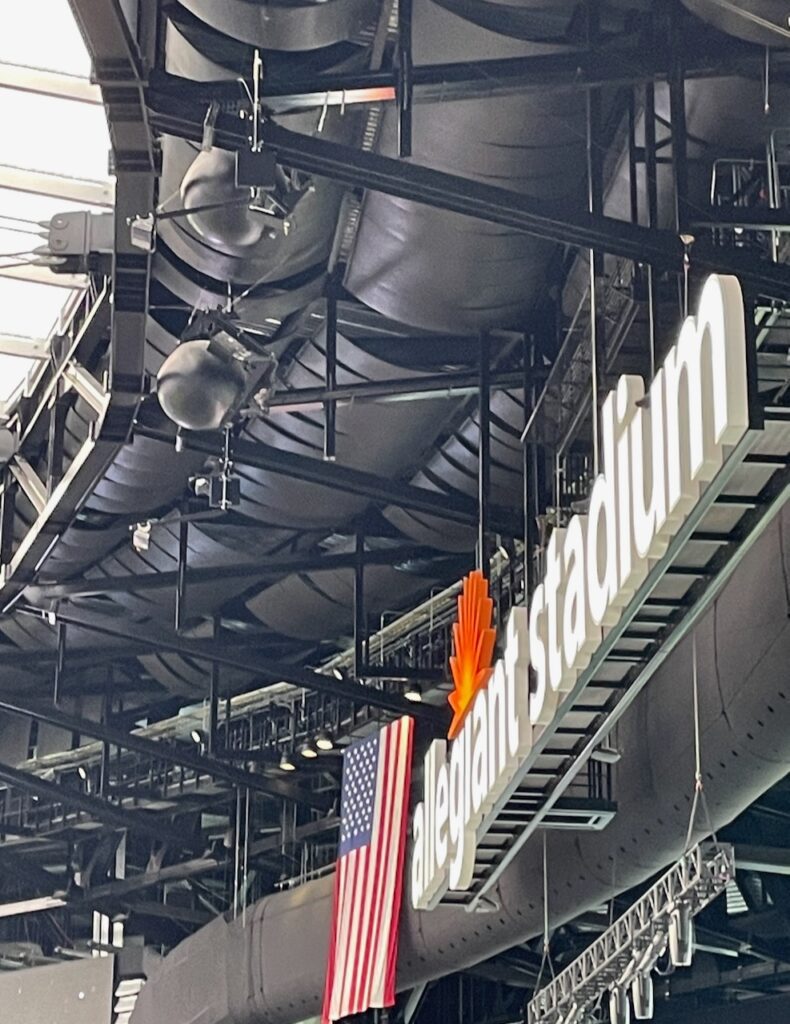
Stadium Tech Report talks to Matt Pasco, vice president of information technology for the Las Vegas Raiders, about how innovative wireless technology helped bring a high-performance fan experience to Allegiant Stadium.
With its stunning space-age architecture, Allegiant Stadium, the home of the Las Vegas Raiders, is a visually striking state-of-the-art stadium design that has already earned rave reviews from fans who have attended events there.
But what might be just as important as the sleek construction, great sight lines and eye-popping videoboards is the technology you can’t see — mainly, the pervasive wireless connectivity and the gear that powers it.
Listen in as we talk with Matt Pasco, vice president of information technology for the Las Vegas Raiders, about how experience, examples, and innovative thinking helped bring a cutting-edge wireless infrastructure to Allegiant Stadium — a cloud of connectivity that’s ready to support the highest bandwidth demands of the world’s biggest events.
Finally, a home to call their own
Editor’s note: This is the sixth episode in our new series of Stadium Tech Report podcasts — take a listen and let us know what you think! Thanks to our podcast title sponsors, ExteNet Systems and MatSing, for their support.
Pasco, who has been with the Raiders for 20 years, talks a bit about how rewarding it was to finally bring to Raiders fans a place they could call home, and a place where the team could better control the fan experience, especially from a technology perspective.
“It’s been great to bring to Raiders fans what they haven’t had before — a great technology building,” Pasco said.
According to Pasco, the NFL’s surveys from the past year have put Allegiant Stadium at the top of the fan satisfaction charts — “and technology touches every part of the fan experience,” he said. But getting there wasn’t easy. Though starting from scratch let the team make its own choices, the balances needed between architecture, construction and physical structures and the technology deployed within — especially wireless — led to an interesting pathway to final decisions, Pasco said.
One choice the Raiders made from the start was that they wanted to own their own distributed antenna system (DAS) for cellular communications, instead of letting a carrier or third-party operator run the DAS. Having control of the DAS, Pasco said, ensured that the Raiders could guarantee that customers would have an equal experience “no matter who their carrier is,” and that the team could chart its own course when it came to the future.
Of course, nobody expected a worldwide pandemic to interfere with stadium construction schedules. The delay of having fans in the building caused some economical stress on the Raiders’ operations, as wireless carriers (perhaps understandably) held off on DAS participation since there weren’t any customers around to use their services.
“We now have all top three carriers signed up, but it was a tough first year,” Pasco said. “Owning your own DAS isn’t for the faint of heart.”
Innovating with MatSing antennas
One of the Raiders’ boldest choices in technology came through their embrace of the MatSing Lens antennas as the main avenue for in-bowl cellular seating coverage. Pasco explains how, as the building came together, other options like under-seat antenna deployment or back-to-front wouldn’t work in Allegiant Stadium given its different construction angles.
“The seats at Allegiant Stadium are tight, with fans close to the field,” Pasco said. “There’s not a lot of room so back to front was not an option.”

But after reading an article about Amalie Arena’s use of MatSing antennas for its full bowl, Pasco wondered if the same technology could support a much bigger venue.
“We ran a model to see if it would work, and not only did the model say it was going to work, it said it would work better than an under-seat deployment,” Pasco said. Fortunately, the top circle of the stadium’s domed infrastructure was a perfect place to mount the MatSing antennas, and now with 30 of the antennas in place, Pasco said the system has delivered as promised.
“It works fantastically,” he said. “All the carriers are pleased.”
Subscribe to the Stadium Tech Report podcast on iTunes!
On the Wi-Fi side, Allegiant Stadium was also the first to use some of Cisco’s new 9104 or “Marlin” antennas, which (like the MatSing antennas) support greater distances between antennas and clients.
Working with DAS integrator DAS Group Professionals, the stadium also has cutting-edge JMA gear to support concourse and back-of-house cellular needs, and CommScope cabling to support all the networks. And while Pasco does take pride in having accomplished one of the stadium’s major goals, there is another big one on the horizon as the NFL’s Super Bowl is scheduled to take place at Allegiant Stadium in February of 2024. DGP and the Raiders last month outlined plans for expanding coverage for “the big game,” including adding more MatSings to support 5G signals (especially in the C-Band) as well as more millimeter wave antennas.
“I’m thrilled every time I go into the building, to see the great, seamless use of technology,” Pasco said. “I feel good that our goal was accomplished.”
PREVIOUS PODCASTS
STR Podcast: We talk technology, tradition and change with Ohio State’s Jim Null and Oklahoma’s David Payne
STR Podcast: How AT&T Stadium rewrote the DAS playbook with its new network
STR Podcast: We talk advanced weapons detection systems with Mike Ellenbogen, founder and chief innovation officer at Evolv Technology
Technical production for the Stadium Tech Report podcast is led by Creative Director Dan Grimsley, and Digital Designer Jackie Nguyen. Web and design work is by David Fares and John David. All contents of the Stadium Tech Report podcast are copyright, Stadium Tech Report. Audio, video and print content may not be re-used without the express written consent of Stadium Tech Report.


